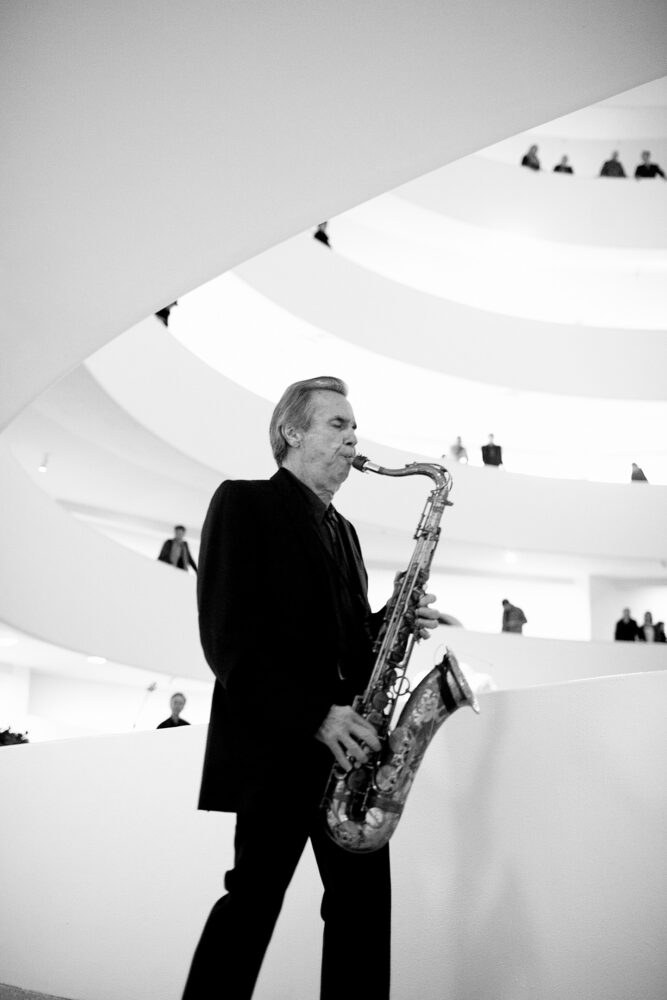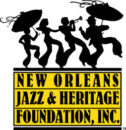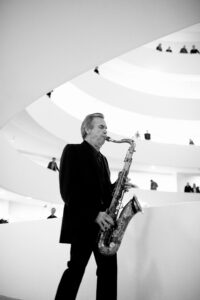A Lot of Saxophones
Cecilia’s own saxophonist Dickie Landry
Published: May 31, 2022
Last Updated: August 30, 2022

Photo by Jenny Gorman
Dickie Landry performing at the Guggenheim Museum.
That’s a note you might expect Richard “Dickie” Landry, who released the minimalist experimental album Fifteen Saxophones in 1977, to have written. In fact, the St. Martin Parish native was its recipient—and the writer was none other than Ornette Coleman. It was the winter of 1968 and Landry’s car, which Landry had just driven all the way up to New York City with a girlfriend, had been completely cleaned out by burglars while the couple ate at a diner: their clothes, his instrument, everything. After their meal, Landry paged through the Village Voice and saw that the free-jazz pioneer was performing that night at the Village Gate on Bleecker Street, not far from his hotel. Coleman was coming up the stairs from the basement nightclub as Landry was heading down, and they exchanged a few words. According to an interview posted on the Leo Castelli Gallery’s blog in July 2020, the headlining saxophonist, who’d grown up in Fort Worth, Texas, and lived in New Orleans briefly, asked the visiting saxophonist about his accent. Landry told Coleman he was from Lafayette; Coleman answered that he’d been beaten up in Louisiana once and had his horn destroyed. Landry countered that he’d been robbed right there in New York City, and lost his own sax, that very night. So Coleman wrote him the note and passed on his phone number.
Landry crossed creative paths with Coleman more than once after that. (The last time, before Coleman’s 2015 death, appears to be a collaboration, in 2010, on a jazz opera in Taipei.) Landry told the story of their serendipitous meeting to interviewers several times over the years. The version he shared with the Castelli Gallery, a supernova of downtown New York cool for nearly five decades, isn’t the most detailed of those. But the interview’s location serves as a handy recent reminder that Dickie Landry, born in the Acadian hamlet of Cecilia in 1938 and raised on a dairy farm, is himself—along with fellow Castelli artists like Robert Rauschenberg, Richard Serra, and Donald Judd—one of those boundary-pushing creators that helped shape the world of contemporary and avant-garde art at a time when it was especially innovative, medium-blurring, and exciting.
Landry had started out in music as a child, singing Gregorian chant in the Catholic church in Cecilia. He picked up the saxophone around age ten when his brother John, eight years his senior, joined the Air Force and left his horn in his little brother’s care. John mailed home records that opened Dickie’s ears to the new soundscapes of contemporary jazz, but there weren’t a lot of opportunities for a grade-schooler in South Louisiana to play it yet. Instead, he honed his chops in the school band, summer music camp, and a local society orchestra that played ballrooms, picking up clarinet and flute as well.
When his car was plundered, Landry wasn’t a rube in the big city. He’d been visiting his older brother every summer since 1956, crazy for live jazz at hot spots like Birdland. In 1962, he spent six weeks in the city studying flute with Arthur Lora, a teacher recommended by the head of the music department at Louisiana State University. (He thought the eighty-dollars-per-lesson fee was steep and practiced fifteen or sixteen hours a day to make it worth it, he told Country Roads magazine in 2009. After the third lesson, he learned why the cost was so high: Lora was the longtime principal flutist for Arturo Toscanini’s NBC Symphony Orchestra.)
Landry would have made the full-time move to New York right then, but there was a slight problem. He’d been busted for growing marijuana back in Lafayette, and the terms of his relatively light punishment—five years’ probation—kept him tethered to Louisiana. He spent the time playing with the Swing Kings, a blue-eyed-soul band popular as an opener for Chitlin’ Circuit acts like Otis Redding and Sam and Dave, and in a jazz trio at New Orleans’s Playboy Club, neither of which activity was permitted under his sentence, either—but he had a sympathetic probation officer, and was released six months early, at the end of 1968. He loaded up the car, went straight back to New York, and got his saxophone stolen.
“One New Year’s Eve we played three jobs in one night. Starting at seven o’clock at night, ended up at seven the next morning.”
One of the only people Landry knew in New York at the time was Keith Sonnier, the abstract sculptor from Mamou who was showing his new works in neon with Castelli. Landry fit in easily with the downtown art crowd, which included not just visual artists like Sonnier, Chuck Close, and Jasper Johns, but dancers, photographers, videographers, and most importantly, experimental musicians like Steve Reich, Laurie Anderson, John Cage, and Philip Glass. On February 19, 1972, Landry presented the first-ever concert at the new Castelli Gallery space on West Broadway in SoHo, the city’s simmering new art zone. His group, which included multiple South Louisianans—saxophonists Richard Peck and Jon Smith, trumpeters and bassists Rusty Gilder and Robert Prado, all of whom would, like Landry, wind up in the legendary minimalist art-sound group the Philip Glass Ensemble—played for nearly five and a half hours. (That show became the lauded double album Solos, released in 1973 on a boutique Philip Glass label.)
That’s the kind of marathon set that Clifton Chenier, back in Louisiana, was famous for—which is worth mentioning because, soon after the launch of his experimental career, Landry was also starting to sit in with the zydeco king whenever he was back at home. (“One New Year’s Eve we played three jobs in one night. Starting at seven o’clock at night, ended up at seven the next morning,” Landry recalled in Todd Mouton’s 2015 book Way Down in Louisiana.) By the late ’70s, Landry, who’d first met Chenier at a Grand Bois hideaway called the Dipsy Doodle, was helping organize a concert for him at Carnegie Hall.
It’s a challenge to run down Landry’s resume without running out of room or defaulting to simple listmaking: he’s exhibited his documentary photographs (mostly of his contemporaries in the New York art scene) and abstract paintings to acclaim in the United States and Europe. He’s composed for opera, theater, and modern dance, as well as one of his main current gigs—performing with Lafayette guitarist C. C. Adcock’s all-star swamp-pop ensemble the Lil’ Band O’ Gold. He linked Terrance Simien up with Paul Simon for the zydeco borrowings on the 1986 landmark Graceland, and lent Louisiana bayou soul to both Bob Dylan and the Band.
Landry didn’t graduate to experimental art music from roots, R&B, soul, or the fundamental jazz of his era: he was a keen, curious, hungry artist who kept—and still keeps—nudging the boundaries of medium, technology, style, and conversation. Fifteen Saxophones didn’t, after all, involve fifteen saxophones, but some new techniques of delay; one of his most recent musical pieces in New Orleans was an hour-long solo saxophone performance at the New Orleans Museum of Art that put his instrument in exploratory conversation with the building’s classical architecture, as attendees were encouraged to move freely throughout the space. Is the bayou fertile and weird? You bet.
A columnist since 2016, Alison Fensterstock has written for 64 Parishes about music, dogs, witches, hippies, and other things.

This article is funded in part by a grant from the
New Orleans Jazz & Heritage Foundation.
